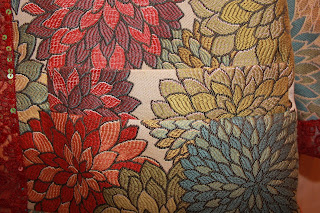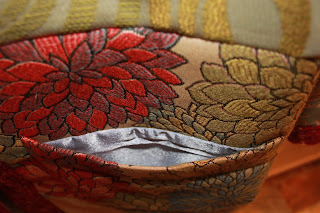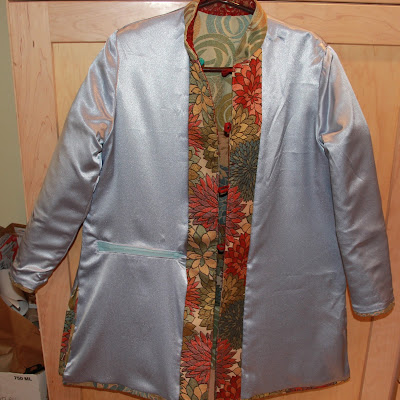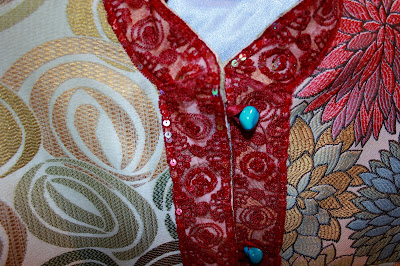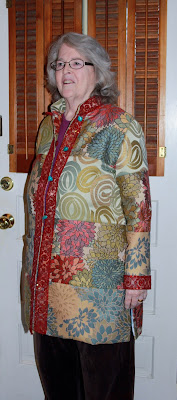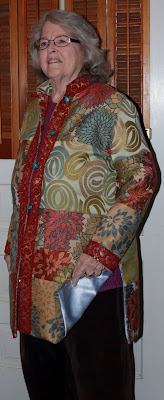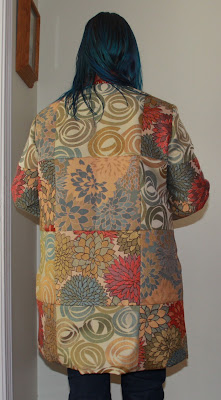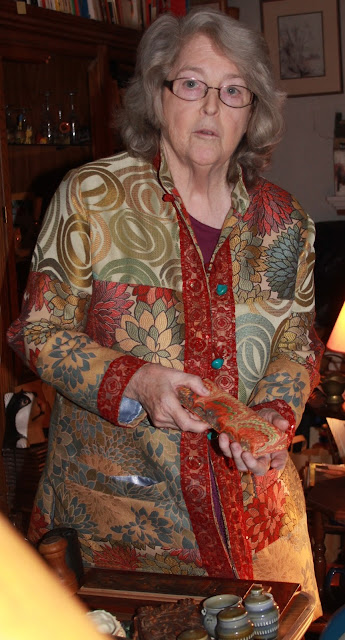So I haven't posted much lately and there is a reason for that....The last couple of weeks have been some of the most frustrating I've ever had from a sewing point of view. I've started not 1, not 2, not 3, but 4 projects in that last few weeks and not one of them has been finished for one reason or another.
I decided that I should probably document some of my issues, and then hopefully I can document my fixes if and when they happen so that next time I encounter these problems I have some idea of what I'm doing.
Project 1 - The Coat
It all started with the coat muslin. I've got a couple of coats in conception phase in my mind. The coat I made last year I love but I wanted to make a few modifications before starting the new coat.
I made myself a coat last year, straight off of Simplicity Pattern 1732
Now whilst I absolutely love this coat it does have a few issues.
The old coat is a bit too wide across the shoulders at the back leading to some bunching
And it also has a few design elements that I don't want on the new coats. Things such as the puffed sleeves. the huge lapels, and finally when its cut off at the 3/4 length as I want my next coat to be, its a bit too flared.
So my plan was to trace the existing pattern pieces onto new paper, then modify it using the sloper that I made earlier. I did this and made up a muslin. After much tweaking and many many many modifications I ended up with this...
(please excuse the hair that really needs to be re-dyed and the ugly muslin material - not my most flattering photos)
The front it pretty much shapeless, the back is ok, but the sleeves are two different patterns and neither or them fit or hang nicely and are both too tight around my arm.
I spent hours and hours trying to get this pattern to work, mainly working with the arm scythe and sleeve. In the end I decided to just throw it out and start all over again,
I decided to go right back to the beginning and create a new sloper. This time however, when measuring for my sloper I was able to use my new dressform.
A couple of months ago I decided that I would love a dress form, with all the sewing I do it would really come in handy. But I didn't want to hand over lots of money just to find that I couldn't adjust it to my dimensions - which is a definite possibility given my proportions. So after searching the internet for many hours I found a do it yourself solution using duct tape. I wasn't sure how well it would work, so rather than jump straight in I decided to try it out on my kids first.
My Daughter My Son
I know that these forms will probably only last for a month or so the way they're growing, but it was still fun, and it'll be fun to look back on just how small they are in later years.
Once I had the trials under my belt I went ahead and tried it on myself. Unfortunately this one didn't work quite so well, but what did I expect when I had a 6 and a 7 year old doing most of the work. From the bust down the form is good, because I was able to do most of it myself, however over the shoulders and across the back, where L did most of the work, it did not come out quite so well, Since across the shoulders and around the arm holes is the area that I have the most problems with, this was very disappointing. In the end however the form was able to be of some use. I was able to use it when measuring for my new sloper. Since I was able to draw marks all over it and they didn't move, it allowed me to get much more accurate measurements which in turn made for a much better sloper.
It's still not perfect, but its a lot better!
At this point however I stalled. After all the work I had put into it I'm a bit afraid to try modifying the sloper into the coat pattern. My original coat pattern is princess seams and I'm still trying to figure out if I want to stay with this or if I go for a darted coat pattern. and once again indecision leads to inaction and the whole project had been thrown in the too hard pile in the corner.
Project 2 - the Orange Dress/Top
So in the mean time I decided to try something a little simpler. I found an orange/black knit fabric during one of my many trips to the fabric store, and I couldn't resist it. I was originally thinking about making a top from this material, then I found this
free Dress Pattern from So Sew Easy and decided I would like to try it out. This actually worked out quite well. I lengthened the sleeves to full length since I've never been a fan of 3/4 length sleeves and cut out the smallest size along the top edges and the largest size down the side seams to allow me to adjust it as required. It did require a little rework along the side seams, letting it out in a few places and taking it in a few others, Whislt the fit ended up OK, the style is not right for me - shows off my big belly, and the fabric choice was also pretty bad. This fabric is just too much as a dress,especially a long sleeve, long dress (which is what the dress ended up as on me when cut out to the pattern).
So the plan here is to cut it off and go back to either a tunic length or a top. Still trying to decide which, and until I do this one is still in the too hard pile in the corner.
Project 3 - The Grey Top
On one of my many trips to the fabric store I found this great piece of grey and white stripe, loosly knit fabric. Its very pretty but very stretchy so I found some great grey fleecy fabric to go underneath it.
 |
| Both fabrics layered together |
I was a bit jaded after all my failures so I thought that I should go back to a real pattern this time around. I went through my patterns and found one that I liked. Simplicity 5133.
I decided on view 2 with the V neck and the bottom band, but again lengthening the sleeves to full length.
I cut out the fleecy material first. Based on my measurements I was between a 14 and 16 around the bust, well above an 18 at the waist and below a 10 for length. I chose size 14 as I figured that the bust was the most important fit in this pattern,....and because my mum had already cut the pattern out to a size 14 (Ok so I'ma bit lazy at times). I sewed the shoulders together and then machine basted the sleeves in. I tried this on and it seemed to be going well so I went ahead and cut out the grey and white fabric. I got it all cut out, re-sewed the shoulder seams with both fabrics, re-basted in one sleeve and pinned the side and sleeve seams and tried it on......it was at this point that I realised that the fleecy grey material I had chosen had no stretch whatsoever...... The whole thing was just too tight.
The plan now is to buy a new under material and try this again. I figure I can re-cut the existing fleecy material into a coat for one of the kids.
But in the mean time - into the pile on the corner this goes.
Project 4 - the Green Top
I still wanted to make the simplicity top - and I had a piece of material that I bought back in Australia that I wanted to make into a top so I started over again. This time I made sure that I tested the stretch of the fabric against the pattern and it looked right so I cut it out - again using the size 14. I sewed the shoulder seams together, then pinned the sleeves in and the side seams together and tried it on.....
This time the pattern is way to big! I can't win. The shoulders are way too wide and the whole thing looks like a tent. I took it off and re-pinned it an extra inch on each side seam plus and an inch down the front and back and it started to look like its supposed to.
I think with this one I'm going to try and re-cut it using my sloper since I don't want to have a seam right down the middle of it and it was nice and long to start with. but in the meantime - to the corner it goes.
This is getting depressing

















